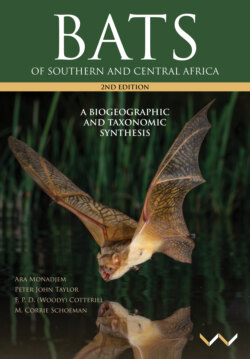Читать книгу Bats of Southern and Central Africa - Ara Monadjem - Страница 47
На сайте Литреса книга снята с продажи.
RECORDING ECHOLOCATION CALLS
ОглавлениеSound originates when matter vibrates in a medium such as air or water, and is perceived by the sense of hearing. Physically, sound is the compression and rarefaction of particles as a wave in the medium through which the sound is travelling. A microphone converts the wave motion of the particles into an electric signal. Special ultrasound microphones are required to record ultrasonic bat frequencies.
Before a complex sound such as a bat’s echolocation call can be manipulated or analysed with a digital computer, the signal must be acquired or digitised by an analog-to-digital (A/D) converter. The A/D converter repeatedly samples the voltage amplitude of the electric input signal at a particular sampling rate, typically tens or hundreds of thousands of times per second. The quality of the resultant digitised signal depends on the rate at which amplitude measurements are made (the sampling rate), and the number of bits used to represent each amplitude measurement (the sample size).
The sampling rate must be more than twice as high as the highest frequency contained in the original signal. Otherwise, the digitised signal will have (phantom) frequencies that were not present in the original signal. This is called aliasing. For example, an accurate recording of an echolocation pulse with a peak frequency of 100 kHz requires a sampling rate of at least 200 kHz.
The precision with which the digitised amplitude represents the actual amplitude at the instant the sample is taken depends on the sample size or number of bits used. Some recording models have an 8-bit sampling limit, while others allow a choice between 8-bit and 16-bit samples. An 8-bit sample can resolve 256 (= 28) different amplitude values; a 16-bit converter can resolve 65,536 (= 216) values.
For the echolocation recordings in this book, the sampling rate (250 or 500 kHz) was always more than twice the highest frequency contained in the original bat signal, and the sample size was 16-bit.
